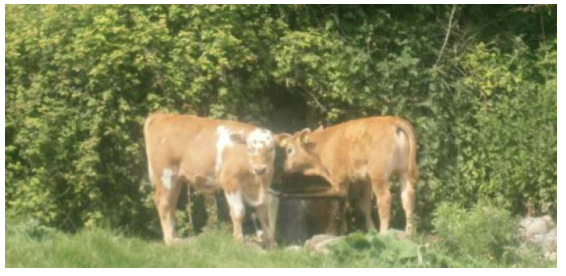Determining the validity of historic agreements concerning the source of a private water supply
In June 2014, a water company was contacted by a local authority about concerns they had about a drinking water supply as a result of carrying out a risk assessment. The source for the supply appeared to be located on land owned by the water company where there were cattle grazing and using a watering trough next to the abstraction point, for what was understood to be the supply to three nearby cottages.
Figure 17: Cows near water trough

This observation ultimately led on to identifying an historic concessionary supply arrangement derived from a decommissioned water treatment works.
Concessionary supplies are historic agreements made between a landowner and one of the former water boards or water authorities. Usually the arrangement was entered into because there was a need to lay a water main across land not owned by the water board or water authority. In return for access to carry out the works, the landowner may have been granted a right to access, and use, a source of water. A feature of concessionary supplies is that they typically comprise a source of untreated raw water intended for use by the landowner for non-domestic purposes, for example, agriculture or the keeping of livestock. However, in some instances landowners went on to make use of the concessionary supply to provide a water supply for domestic purposes to dwellings. Often this was done without first putting in place the means of making the water supply wholesome and fit for purpose. Unfortunately it is a simple fact of history that these unsatisfactory domestic water supply arrangements came into being and have persisted unknown to the authorities until recently when an effective regime of regulation for safeguarding the quality and safety of both public and private water supplies came into force.
After being contacted by the local authority, the water company reviewed the historic records. These showed how, in 1938, a concessionary supply arrangement was established between the then local council and the residents of three cottages who were granted use of water from the springs. The agreement allowed the proprietors, their resident families and the direct descendants of these residents to enjoy a free supply of spring water. The arrangements then changed when the local council transferred its water responsibilities to the local Water Board, which were transferred subsequently in 1973 to the Water Authority and in 1989 to the water company that operates the water supply today. A review of land registry documents and title plans for the individual cottages revealed that the concession was only binding if the present day occupiers of the cottages were linear descendants of the original landowner from the 1930’s. Since the current occupiers were not direct linear descendants the concessionary agreement was deemed as having fallen away. The outcome of the review was confirmation to the local authority that this was a private supply to be regulated by them (it was not a concessionary supply). The next step taken by the local authority was to advise users of the private supply to boil their water to safeguard health and by November, each of the property owners had accepted an offer from the water company to connect to a nearby mains water supply.
This case study illustrates the value that can be derived from the process of risk assessing private supplies. In particular, the requirement for an up to date schematic outlining the supply from source to tap, together with associated documentation about the abstraction arrangements, affords an opportunity for misunderstandings or changes of use to be identified and remedied.
